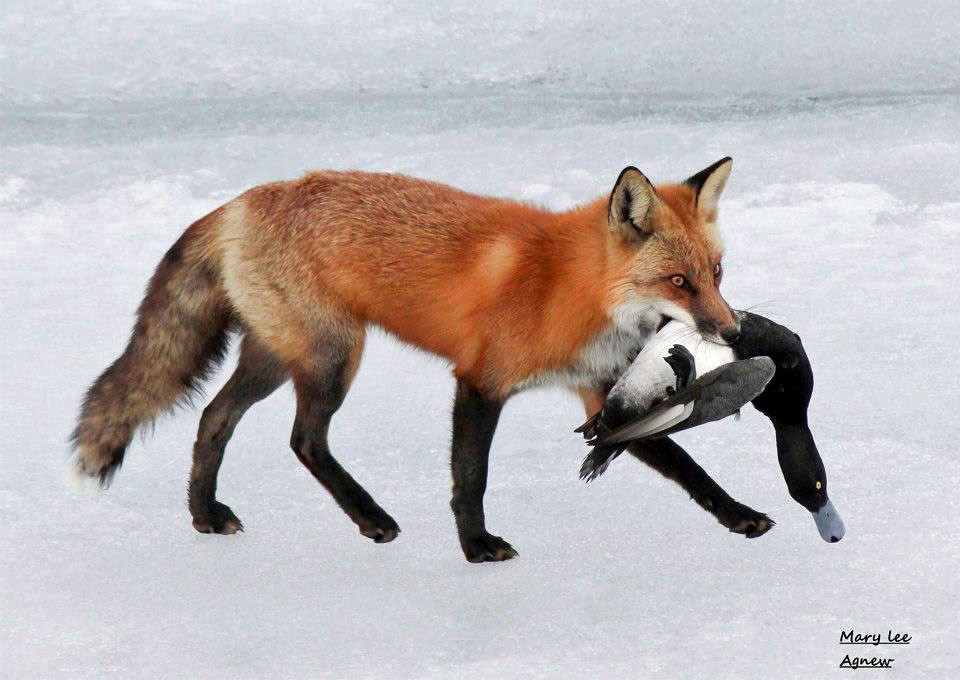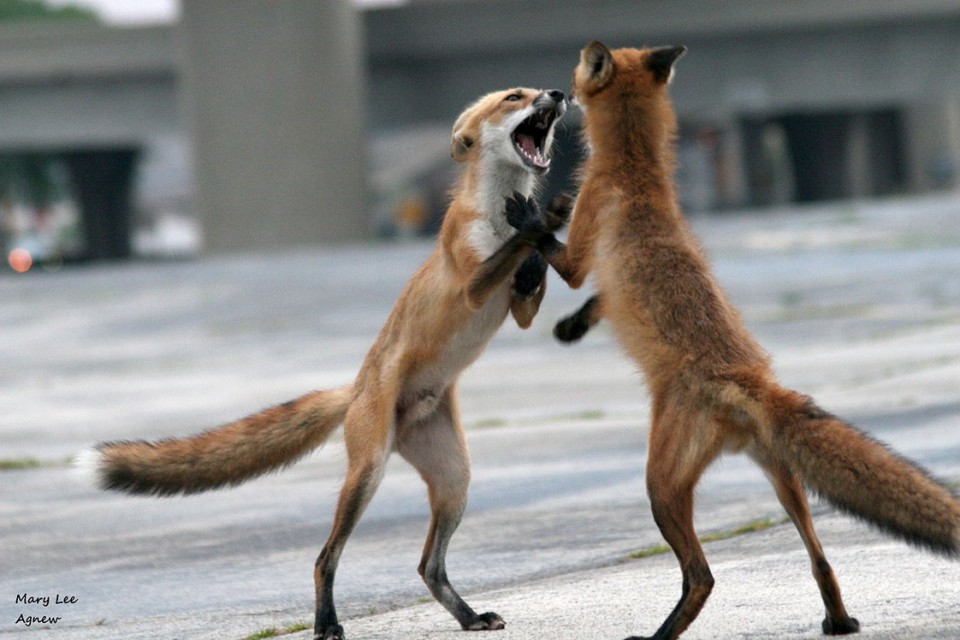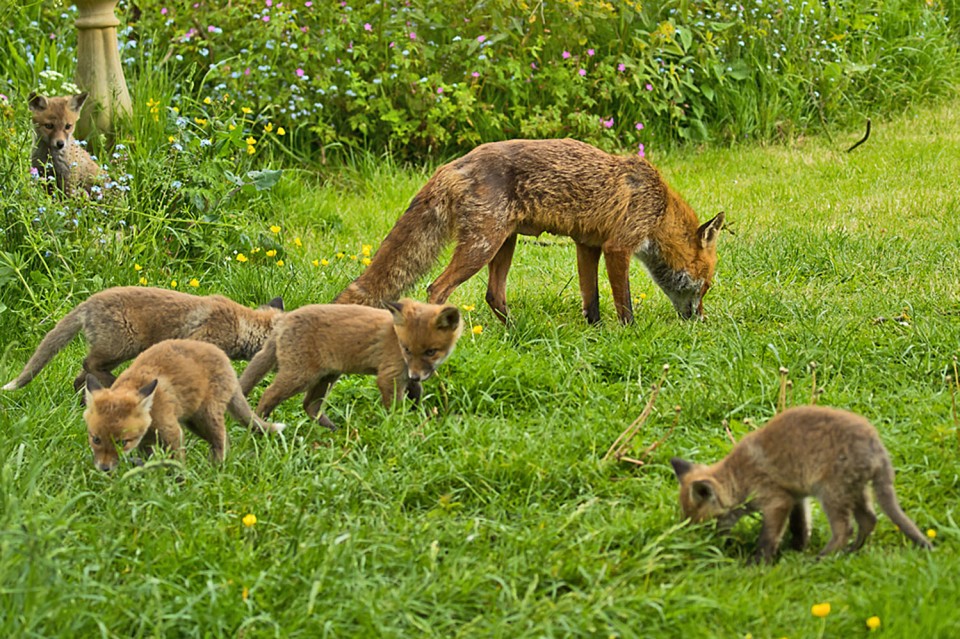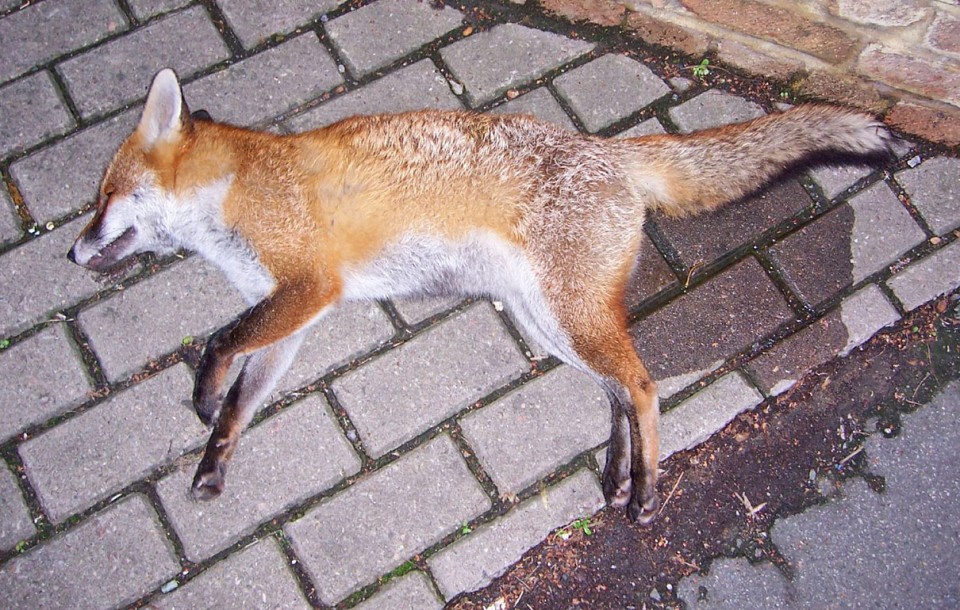Red Fox Breeding - Number of Breeding Vixens
The question of how many vixens in a population will come into oestrous and what controls this at the population level is an interesting one. Conventionally it has been considered that, where several vixens coexist, only one (dominant) female will breed and that she suppresses the reproduction of any others. Quite how the vixen does this was a matter of some debate, but one suggestion was that she restricts subordinate access to food. Indeed, there is a well-known connection between food availability and breeding condition in foxes. In the early 1940s, for example, Russian biologist A.F. Chirkova recognised that food availability played an important part in reproductive success in foxes; she noted that, in poor food years, females would not come on heat, that ova (eggs) wouldn’t be fertilised, and that sporadic losses of embryos would occur.
Subsequent work by Erik Lindström in Sweden during the 1980s revealed a similar picture; he demonstrated how productivity was related to food availability such that vixens in good condition were more fecund and lost fewer foetuses than those in poorer condition. Furthermore, Lindström found that the yearly ovulation rate in his study population was closely correlated with the vole supply at the time of cub birth (in spring), suggesting foxes could “anticipate future food supply”. Lindström suggested that the foxes may be able to react to the presence of reproducing voles during the winter, which signifies a subsequent ‘peak’ in the cycle. In a 1988 paper to the journal Oikos, he even goes so far as to propose a mechanism, suggesting that small quantities of vole reproductive hormones ingested by the fox could be the trigger for the 30-40% increase he observed in fox fecundity.

It would seem, however, that the availability of food and condition of the vixen is not the whole story and, in his paper in the 1980 Biogeographica on fox ecology, A.V. Braunschweig noted that, in agricultural areas of central Sweden, nearly all vixens ovulated each year, but a high proportion (40% to 64%) were barren, even when rodents were abundant. Similarly, a 1996 study in the Pisa province of central Italy by Paolo Cavallini and Simona Santini found that, although larger vixens generally produced larger litters than smaller ones (a commonly observed trait), body mass (i.e. subcutaneous fat levels) wasn’t correlated with ovulation rate or the number of ova or foetuses lost. In other words, breeding performance was not affected by how well-fed these vixens were – something else was at play.
Seven years before Cavallini and Santini’s investigation, Erik Lindström had formulated a theory that, while the breeding of vixens at high latitudes was limited by food, those further south were being limited by social stresses – i.e. the dominant vixen was harassing any subordinate vixens to such an extent that they either didn’t conceive, or lost their embryos. In 1994, a team of biologists—fronted by Bristol University’s Gill Hartley—published their observations on the endocrinology (the production and action of hormones within the body) of captive foxes in the Journal of Reproduction and Fertility.
Hartley and her co-workers kept 11 orphaned vixens and seven males in family groups (i.e. one sexually mature dog, with mature vixens where mother-daughter relationships were maintained) and found that only one vixen in each group successfully produced cubs. All the vixens came into oestrous and were mated, but those that failed to breed (i.e. didn’t implant their fertilised ova) showed changes in the levels of two important hormones: a reduction in progesterone and high cortisol levels.

Progesterone prepares the uterine lining to receive the ova and without it pregnancy cannot be maintained, while cortisol is an adrenal hormone that is produced in response to stress. Essentially, Hartley found evidence suggesting that the non-breeding vixens were ‘stressed out’ by the dominant ones and this caused a change in their hormones that caused them to abort their fertilized ova around the time of implantation. Observations on fox populations from across their range have shown that within-group aggression increases towards the breeding season and it is possible that this increased hostility of the mother towards her daughters causes the rise in cortisol and associated drop in progesterone that drives this social stress mechanism.
The data collected by Hartley and her colleagues may be only part of the answer to the question of why some foxes fail to breed even when food is abundant. We know from the studies on Bristol’s foxes that, in some urban populations at least, subordinates do mate and many conceive. Interestingly, unless there is a super-abundance of food or the dominant vixen is killed, about 20% of these subordinates abort their litters very late term, rather than at the pre-implantation stage as Hartley documented. Similarly, in 1981, Torbjörn von Schantz described how non-breeding females in his study population in Sweden regularly became pregnant but aborted or deserted their young. This is thought to be a kind of “keep your cards hidden until the last minute” strategy.
There is some evidence to suggest a behavioural mechanism that could reduce subordinate breeding and, in his 1987 book, Running with the Fox, David Macdonald noted that the dog in his captive social group was only interested in the dominant vixen (called “Niff”) during the breeding season, despite the subordinates ‘flirting’ with him. Macdonald also found that when he removed the dominant pair and introduced an un-related dog fox stranger, only Niff’s eldest daughter—who was barren for five years under her mother’s matriarchy—mated and produced cubs. This implies that dogs are only attracted to the dominant vixen in a group. Assuming this is representative of the wild, subordinate matings within a social group presumably occur away from the group, where the dog is perhaps less able to assess social rank. Interestingly, however, Macdonald's observations are in contrast of those of West Sussex-based fox watcher Onyx Stewart. In the fox family Stewart has been studying in his garden, comprising two sisters and an unrelated male, it is the subordinate vixen that paired with the dog. Apparently the more dominant sibling has never been observed to mate, the male having never appeared to show any interest in her.

Despite all of the foregoing, it is not unknown for subordinates to produce litters, particularly in urban areas; the cubs may subsequently be killed by the dominant vixen (infanticide) or the other litter(s) may be raised independently or combined with the dominant vixen’s cubs and raised together.
Whatever the full picture may turn out to be, the number of non-breeding (sometimes called “barren” or, archaically, “dry” owing to their failure to produce milk) vixens in a population is highly variable. In ideal conditions (i.e. sufficient food and low fox density), some 80% to 100% of vixens will breed, while only around 30% may breed in unfavourable years. In rural Oxford, where mortality was low, Macdonald found that around 60% of vixens were barren, compared with the 24% Stephen Harris found in London, the 20% Cavallini and Santini recorded in Italy and the 8.5% Nicola Marlow and her colleagues found in Western Australia. Elsewhere in Europe and in the USA, where foxes are heavily trapped for fur and as rabies control, only around 10% will be barren.
There is also variability associated with age – older vixens are more likely to breed than younger ones (in some studies, about 50% of yearlings breed in any given year compared with 90% or more mature vixens). As Macdonald pointed to in his book, the importance of the interaction between food, territoriality and social behaviour cannot be under-estimated and explains why the proportions of breeding and barren vixens, and litter size, change between years and in different habitats. Food controls territory, which in turn regulates sociality and thus determines the number of breeding vixens in an area. The level of mortality (natural and human-mediated) can further affect territoriality such that a high percentage of barren vixens in an area indicates that the foxes are living in stable social groups with reliable food and low mortality/persecution.

Finally, disease can interfere with fox reproduction. During their extensive study on the impact sarcoptic mange had on Bristol’s urban fox population, Carl Soulsbury and his colleagues found that females with advanced mange didn’t breed, while severely infected males failed to undergo spermatogenesis (i.e. they didn’t produce any viable sperm).
Following successful ejaculation, a bulb at the end of the dog fox's penis engorges with blood and causes the pair to temporarily lock together - this is known as a copulatory tie. The tie can last anywhere from a few minutes to an hour-or-so. The back-to-back arrangement is an anti-predator mechanism - eyes and teeth both ends serve to dissuade potential attackers while the foxes are otherwise highly vulnerable.